Small and Medium-Sized Enterprises: Growth and Financial Contribution in the UK Economy
VerifiedAdded on 2022/11/14
|17
|5116
|73
AI Summary
This article defines SMEs in the UK and evaluates their growth and financial contribution to the economy. It also analyzes the political and economic factors affecting their development, including the impact of Brexit. The article compares the impact of SMEs in different UK regions and industries, and examines the difference between an entrepreneur and a manager. Finally, it explores the entrepreneurial characteristics needed for successful business activities.
Contribute Materials
Your contribution can guide someone’s learning journey. Share your
documents today.
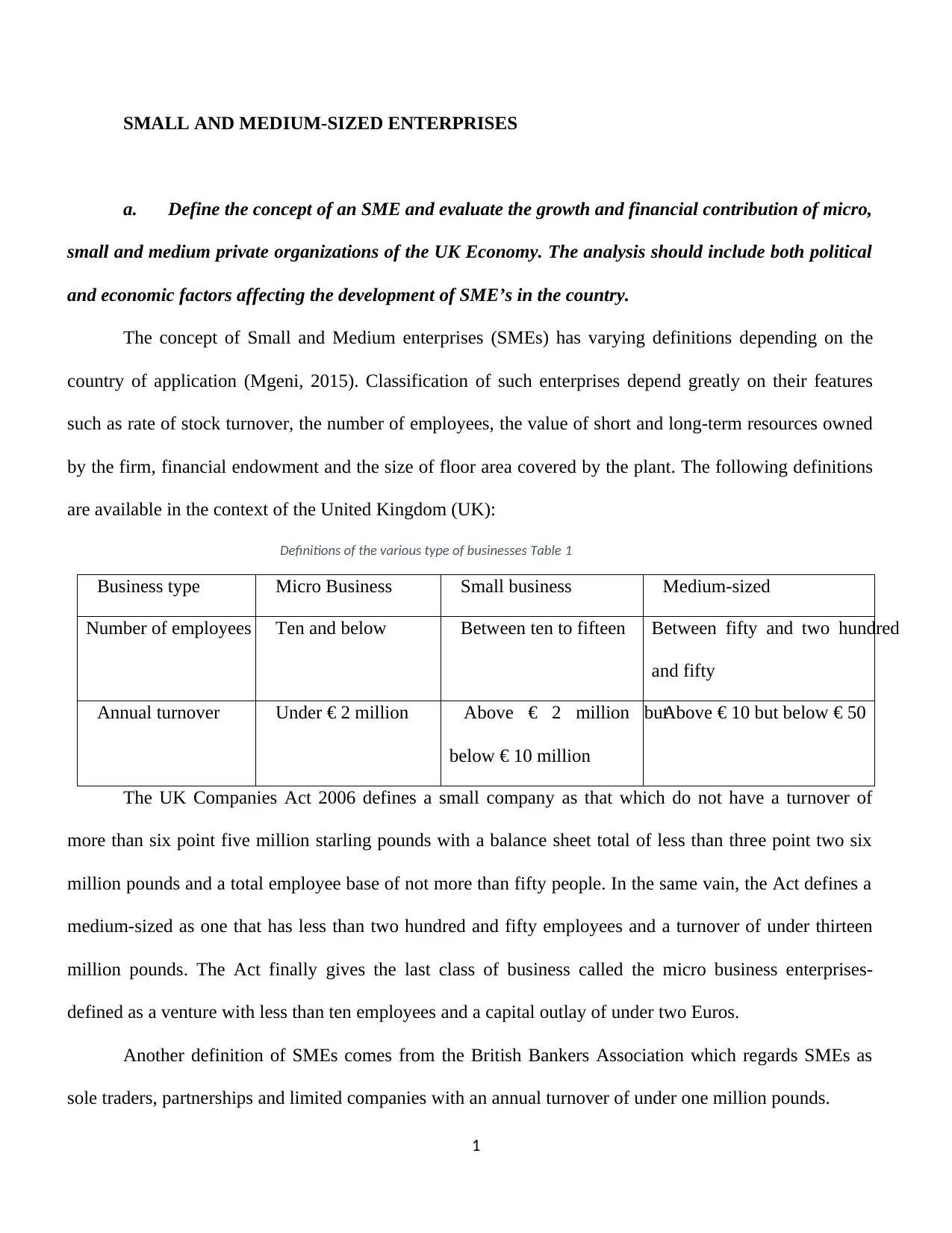
SMALL AND MEDIUM-SIZED ENTERPRISES
a. Define the concept of an SME and evaluate the growth and financial contribution of micro,
small and medium private organizations of the UK Economy. The analysis should include both political
and economic factors affecting the development of SME’s in the country.
The concept of Small and Medium enterprises (SMEs) has varying definitions depending on the
country of application (Mgeni, 2015). Classification of such enterprises depend greatly on their features
such as rate of stock turnover, the number of employees, the value of short and long-term resources owned
by the firm, financial endowment and the size of floor area covered by the plant. The following definitions
are available in the context of the United Kingdom (UK):
Definitions of the various type of businesses Table 1
Business type Micro Business Small business Medium-sized
Number of employees Ten and below Between ten to fifteen Between fifty and two hundred
and fifty
Annual turnover Under € 2 million Above € 2 million but
below € 10 million
Above € 10 but below € 50
The UK Companies Act 2006 defines a small company as that which do not have a turnover of
more than six point five million starling pounds with a balance sheet total of less than three point two six
million pounds and a total employee base of not more than fifty people. In the same vain, the Act defines a
medium-sized as one that has less than two hundred and fifty employees and a turnover of under thirteen
million pounds. The Act finally gives the last class of business called the micro business enterprises-
defined as a venture with less than ten employees and a capital outlay of under two Euros.
Another definition of SMEs comes from the British Bankers Association which regards SMEs as
sole traders, partnerships and limited companies with an annual turnover of under one million pounds.
1
a. Define the concept of an SME and evaluate the growth and financial contribution of micro,
small and medium private organizations of the UK Economy. The analysis should include both political
and economic factors affecting the development of SME’s in the country.
The concept of Small and Medium enterprises (SMEs) has varying definitions depending on the
country of application (Mgeni, 2015). Classification of such enterprises depend greatly on their features
such as rate of stock turnover, the number of employees, the value of short and long-term resources owned
by the firm, financial endowment and the size of floor area covered by the plant. The following definitions
are available in the context of the United Kingdom (UK):
Definitions of the various type of businesses Table 1
Business type Micro Business Small business Medium-sized
Number of employees Ten and below Between ten to fifteen Between fifty and two hundred
and fifty
Annual turnover Under € 2 million Above € 2 million but
below € 10 million
Above € 10 but below € 50
The UK Companies Act 2006 defines a small company as that which do not have a turnover of
more than six point five million starling pounds with a balance sheet total of less than three point two six
million pounds and a total employee base of not more than fifty people. In the same vain, the Act defines a
medium-sized as one that has less than two hundred and fifty employees and a turnover of under thirteen
million pounds. The Act finally gives the last class of business called the micro business enterprises-
defined as a venture with less than ten employees and a capital outlay of under two Euros.
Another definition of SMEs comes from the British Bankers Association which regards SMEs as
sole traders, partnerships and limited companies with an annual turnover of under one million pounds.
1
Secure Best Marks with AI Grader
Need help grading? Try our AI Grader for instant feedback on your assignments.
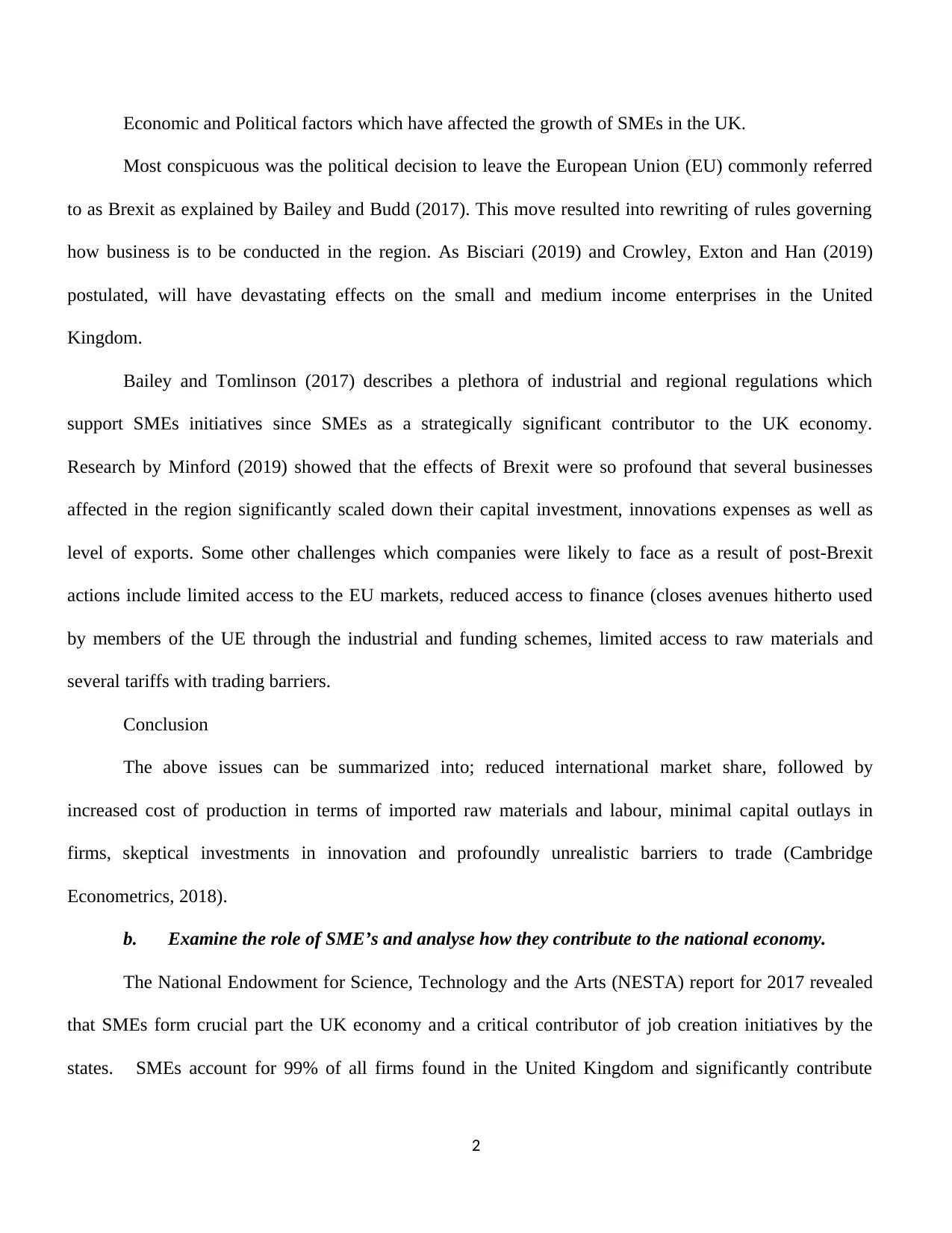
Economic and Political factors which have affected the growth of SMEs in the UK.
Most conspicuous was the political decision to leave the European Union (EU) commonly referred
to as Brexit as explained by Bailey and Budd (2017). This move resulted into rewriting of rules governing
how business is to be conducted in the region. As Bisciari (2019) and Crowley, Exton and Han (2019)
postulated, will have devastating effects on the small and medium income enterprises in the United
Kingdom.
Bailey and Tomlinson (2017) describes a plethora of industrial and regional regulations which
support SMEs initiatives since SMEs as a strategically significant contributor to the UK economy.
Research by Minford (2019) showed that the effects of Brexit were so profound that several businesses
affected in the region significantly scaled down their capital investment, innovations expenses as well as
level of exports. Some other challenges which companies were likely to face as a result of post-Brexit
actions include limited access to the EU markets, reduced access to finance (closes avenues hitherto used
by members of the UE through the industrial and funding schemes, limited access to raw materials and
several tariffs with trading barriers.
Conclusion
The above issues can be summarized into; reduced international market share, followed by
increased cost of production in terms of imported raw materials and labour, minimal capital outlays in
firms, skeptical investments in innovation and profoundly unrealistic barriers to trade (Cambridge
Econometrics, 2018).
b. Examine the role of SME’s and analyse how they contribute to the national economy.
The National Endowment for Science, Technology and the Arts (NESTA) report for 2017 revealed
that SMEs form crucial part the UK economy and a critical contributor of job creation initiatives by the
states. SMEs account for 99% of all firms found in the United Kingdom and significantly contribute
2
Most conspicuous was the political decision to leave the European Union (EU) commonly referred
to as Brexit as explained by Bailey and Budd (2017). This move resulted into rewriting of rules governing
how business is to be conducted in the region. As Bisciari (2019) and Crowley, Exton and Han (2019)
postulated, will have devastating effects on the small and medium income enterprises in the United
Kingdom.
Bailey and Tomlinson (2017) describes a plethora of industrial and regional regulations which
support SMEs initiatives since SMEs as a strategically significant contributor to the UK economy.
Research by Minford (2019) showed that the effects of Brexit were so profound that several businesses
affected in the region significantly scaled down their capital investment, innovations expenses as well as
level of exports. Some other challenges which companies were likely to face as a result of post-Brexit
actions include limited access to the EU markets, reduced access to finance (closes avenues hitherto used
by members of the UE through the industrial and funding schemes, limited access to raw materials and
several tariffs with trading barriers.
Conclusion
The above issues can be summarized into; reduced international market share, followed by
increased cost of production in terms of imported raw materials and labour, minimal capital outlays in
firms, skeptical investments in innovation and profoundly unrealistic barriers to trade (Cambridge
Econometrics, 2018).
b. Examine the role of SME’s and analyse how they contribute to the national economy.
The National Endowment for Science, Technology and the Arts (NESTA) report for 2017 revealed
that SMEs form crucial part the UK economy and a critical contributor of job creation initiatives by the
states. SMEs account for 99% of all firms found in the United Kingdom and significantly contribute
2
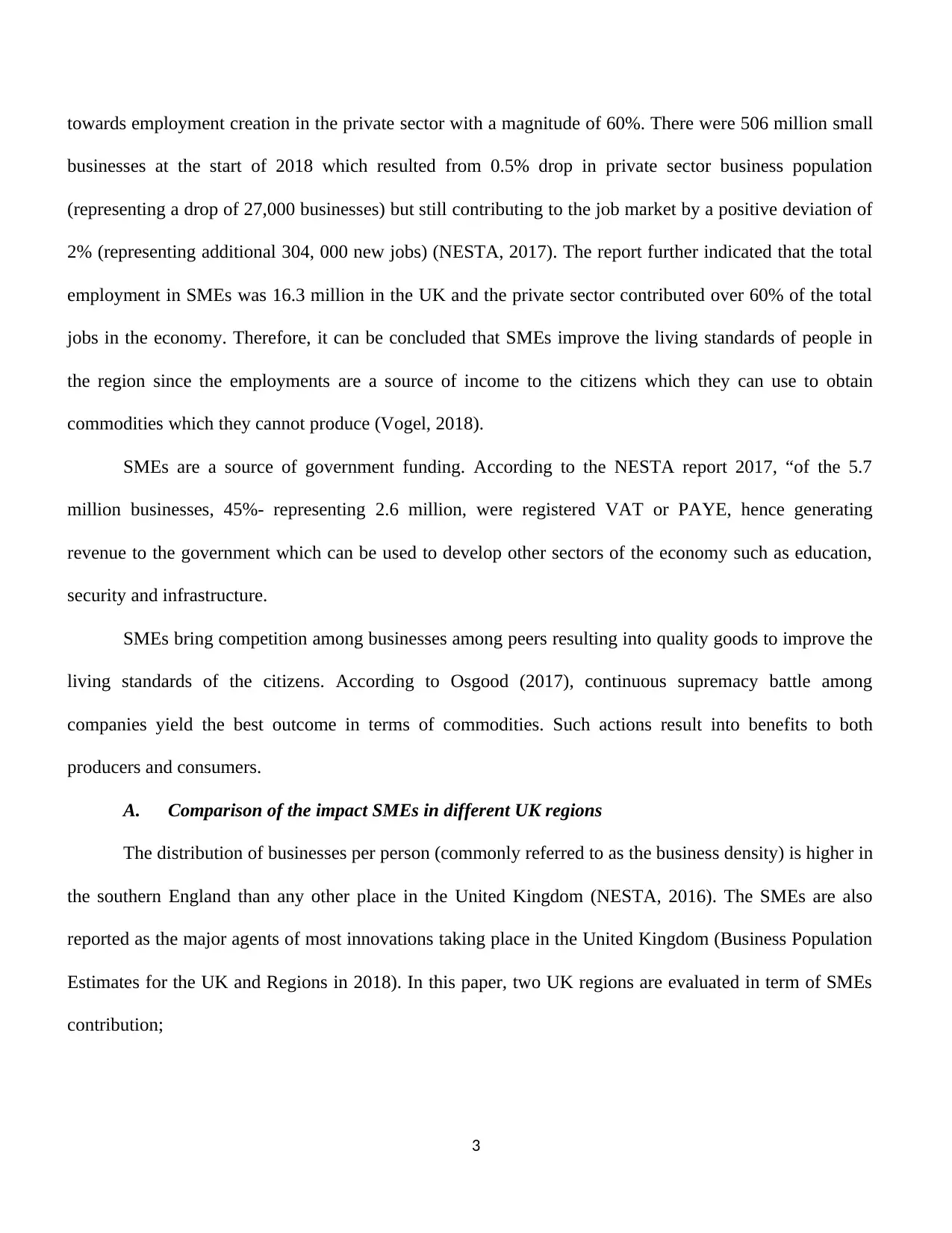
towards employment creation in the private sector with a magnitude of 60%. There were 506 million small
businesses at the start of 2018 which resulted from 0.5% drop in private sector business population
(representing a drop of 27,000 businesses) but still contributing to the job market by a positive deviation of
2% (representing additional 304, 000 new jobs) (NESTA, 2017). The report further indicated that the total
employment in SMEs was 16.3 million in the UK and the private sector contributed over 60% of the total
jobs in the economy. Therefore, it can be concluded that SMEs improve the living standards of people in
the region since the employments are a source of income to the citizens which they can use to obtain
commodities which they cannot produce (Vogel, 2018).
SMEs are a source of government funding. According to the NESTA report 2017, “of the 5.7
million businesses, 45%- representing 2.6 million, were registered VAT or PAYE, hence generating
revenue to the government which can be used to develop other sectors of the economy such as education,
security and infrastructure.
SMEs bring competition among businesses among peers resulting into quality goods to improve the
living standards of the citizens. According to Osgood (2017), continuous supremacy battle among
companies yield the best outcome in terms of commodities. Such actions result into benefits to both
producers and consumers.
A. Comparison of the impact SMEs in different UK regions
The distribution of businesses per person (commonly referred to as the business density) is higher in
the southern England than any other place in the United Kingdom (NESTA, 2016). The SMEs are also
reported as the major agents of most innovations taking place in the United Kingdom (Business Population
Estimates for the UK and Regions in 2018). In this paper, two UK regions are evaluated in term of SMEs
contribution;
3
businesses at the start of 2018 which resulted from 0.5% drop in private sector business population
(representing a drop of 27,000 businesses) but still contributing to the job market by a positive deviation of
2% (representing additional 304, 000 new jobs) (NESTA, 2017). The report further indicated that the total
employment in SMEs was 16.3 million in the UK and the private sector contributed over 60% of the total
jobs in the economy. Therefore, it can be concluded that SMEs improve the living standards of people in
the region since the employments are a source of income to the citizens which they can use to obtain
commodities which they cannot produce (Vogel, 2018).
SMEs are a source of government funding. According to the NESTA report 2017, “of the 5.7
million businesses, 45%- representing 2.6 million, were registered VAT or PAYE, hence generating
revenue to the government which can be used to develop other sectors of the economy such as education,
security and infrastructure.
SMEs bring competition among businesses among peers resulting into quality goods to improve the
living standards of the citizens. According to Osgood (2017), continuous supremacy battle among
companies yield the best outcome in terms of commodities. Such actions result into benefits to both
producers and consumers.
A. Comparison of the impact SMEs in different UK regions
The distribution of businesses per person (commonly referred to as the business density) is higher in
the southern England than any other place in the United Kingdom (NESTA, 2016). The SMEs are also
reported as the major agents of most innovations taking place in the United Kingdom (Business Population
Estimates for the UK and Regions in 2018). In this paper, two UK regions are evaluated in term of SMEs
contribution;
3
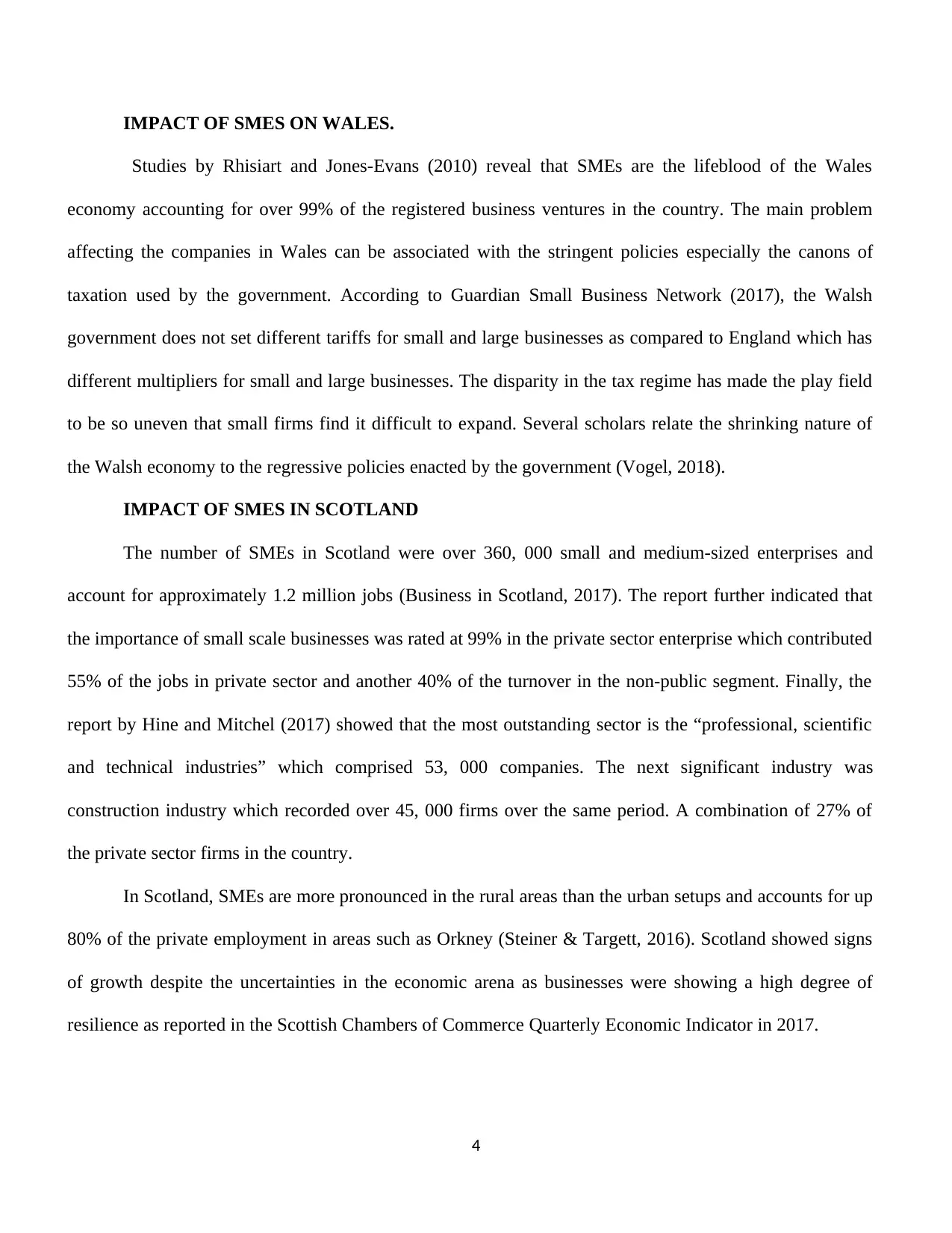
IMPACT OF SMES ON WALES.
Studies by Rhisiart and Jones-Evans (2010) reveal that SMEs are the lifeblood of the Wales
economy accounting for over 99% of the registered business ventures in the country. The main problem
affecting the companies in Wales can be associated with the stringent policies especially the canons of
taxation used by the government. According to Guardian Small Business Network (2017), the Walsh
government does not set different tariffs for small and large businesses as compared to England which has
different multipliers for small and large businesses. The disparity in the tax regime has made the play field
to be so uneven that small firms find it difficult to expand. Several scholars relate the shrinking nature of
the Walsh economy to the regressive policies enacted by the government (Vogel, 2018).
IMPACT OF SMES IN SCOTLAND
The number of SMEs in Scotland were over 360, 000 small and medium-sized enterprises and
account for approximately 1.2 million jobs (Business in Scotland, 2017). The report further indicated that
the importance of small scale businesses was rated at 99% in the private sector enterprise which contributed
55% of the jobs in private sector and another 40% of the turnover in the non-public segment. Finally, the
report by Hine and Mitchel (2017) showed that the most outstanding sector is the “professional, scientific
and technical industries” which comprised 53, 000 companies. The next significant industry was
construction industry which recorded over 45, 000 firms over the same period. A combination of 27% of
the private sector firms in the country.
In Scotland, SMEs are more pronounced in the rural areas than the urban setups and accounts for up
80% of the private employment in areas such as Orkney (Steiner & Targett, 2016). Scotland showed signs
of growth despite the uncertainties in the economic arena as businesses were showing a high degree of
resilience as reported in the Scottish Chambers of Commerce Quarterly Economic Indicator in 2017.
4
Studies by Rhisiart and Jones-Evans (2010) reveal that SMEs are the lifeblood of the Wales
economy accounting for over 99% of the registered business ventures in the country. The main problem
affecting the companies in Wales can be associated with the stringent policies especially the canons of
taxation used by the government. According to Guardian Small Business Network (2017), the Walsh
government does not set different tariffs for small and large businesses as compared to England which has
different multipliers for small and large businesses. The disparity in the tax regime has made the play field
to be so uneven that small firms find it difficult to expand. Several scholars relate the shrinking nature of
the Walsh economy to the regressive policies enacted by the government (Vogel, 2018).
IMPACT OF SMES IN SCOTLAND
The number of SMEs in Scotland were over 360, 000 small and medium-sized enterprises and
account for approximately 1.2 million jobs (Business in Scotland, 2017). The report further indicated that
the importance of small scale businesses was rated at 99% in the private sector enterprise which contributed
55% of the jobs in private sector and another 40% of the turnover in the non-public segment. Finally, the
report by Hine and Mitchel (2017) showed that the most outstanding sector is the “professional, scientific
and technical industries” which comprised 53, 000 companies. The next significant industry was
construction industry which recorded over 45, 000 firms over the same period. A combination of 27% of
the private sector firms in the country.
In Scotland, SMEs are more pronounced in the rural areas than the urban setups and accounts for up
80% of the private employment in areas such as Orkney (Steiner & Targett, 2016). Scotland showed signs
of growth despite the uncertainties in the economic arena as businesses were showing a high degree of
resilience as reported in the Scottish Chambers of Commerce Quarterly Economic Indicator in 2017.
4
Secure Best Marks with AI Grader
Need help grading? Try our AI Grader for instant feedback on your assignments.
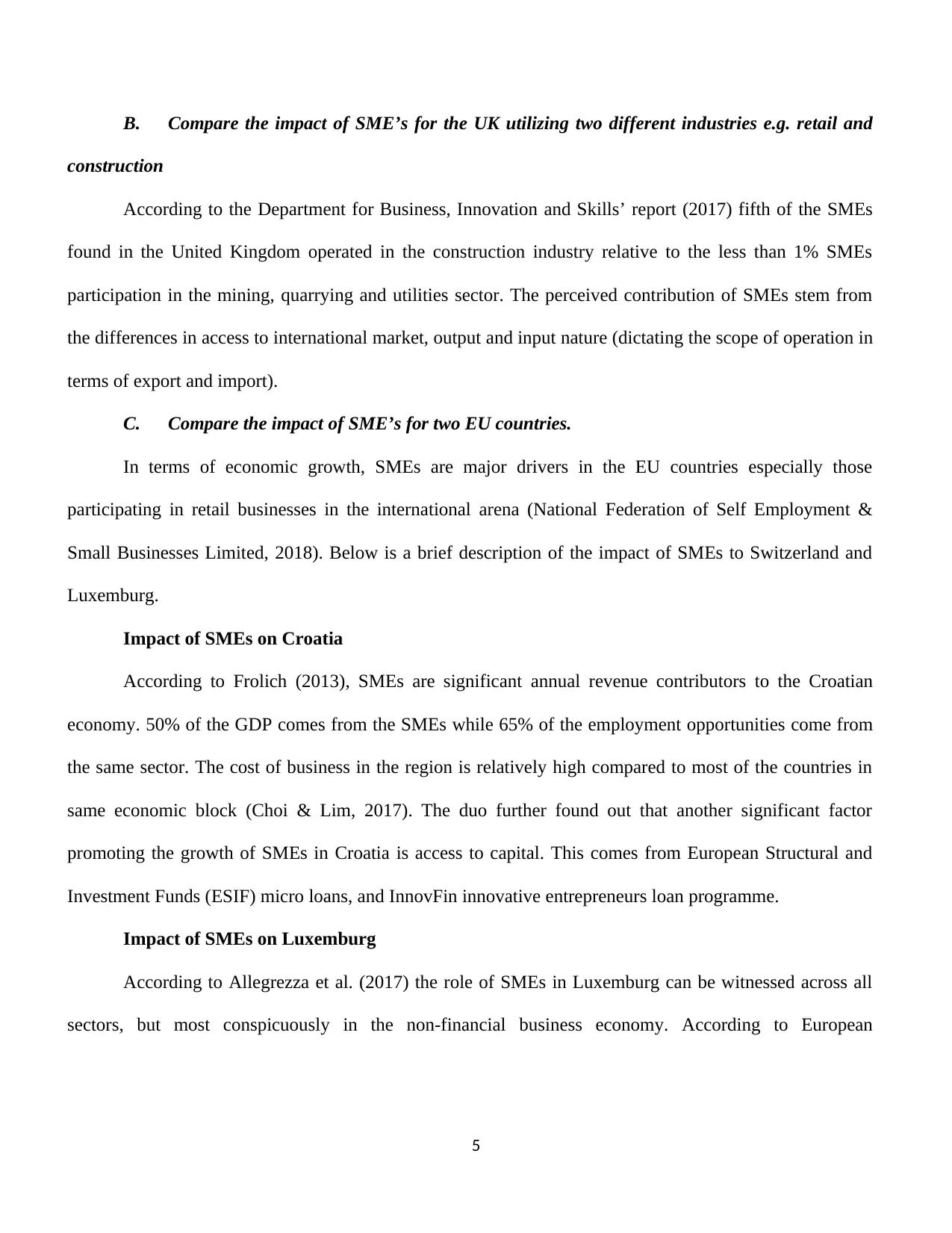
B. Compare the impact of SME’s for the UK utilizing two different industries e.g. retail and
construction
According to the Department for Business, Innovation and Skills’ report (2017) fifth of the SMEs
found in the United Kingdom operated in the construction industry relative to the less than 1% SMEs
participation in the mining, quarrying and utilities sector. The perceived contribution of SMEs stem from
the differences in access to international market, output and input nature (dictating the scope of operation in
terms of export and import).
C. Compare the impact of SME’s for two EU countries.
In terms of economic growth, SMEs are major drivers in the EU countries especially those
participating in retail businesses in the international arena (National Federation of Self Employment &
Small Businesses Limited, 2018). Below is a brief description of the impact of SMEs to Switzerland and
Luxemburg.
Impact of SMEs on Croatia
According to Frolich (2013), SMEs are significant annual revenue contributors to the Croatian
economy. 50% of the GDP comes from the SMEs while 65% of the employment opportunities come from
the same sector. The cost of business in the region is relatively high compared to most of the countries in
same economic block (Choi & Lim, 2017). The duo further found out that another significant factor
promoting the growth of SMEs in Croatia is access to capital. This comes from European Structural and
Investment Funds (ESIF) micro loans, and InnovFin innovative entrepreneurs loan programme.
Impact of SMEs on Luxemburg
According to Allegrezza et al. (2017) the role of SMEs in Luxemburg can be witnessed across all
sectors, but most conspicuously in the non-financial business economy. According to European
5
construction
According to the Department for Business, Innovation and Skills’ report (2017) fifth of the SMEs
found in the United Kingdom operated in the construction industry relative to the less than 1% SMEs
participation in the mining, quarrying and utilities sector. The perceived contribution of SMEs stem from
the differences in access to international market, output and input nature (dictating the scope of operation in
terms of export and import).
C. Compare the impact of SME’s for two EU countries.
In terms of economic growth, SMEs are major drivers in the EU countries especially those
participating in retail businesses in the international arena (National Federation of Self Employment &
Small Businesses Limited, 2018). Below is a brief description of the impact of SMEs to Switzerland and
Luxemburg.
Impact of SMEs on Croatia
According to Frolich (2013), SMEs are significant annual revenue contributors to the Croatian
economy. 50% of the GDP comes from the SMEs while 65% of the employment opportunities come from
the same sector. The cost of business in the region is relatively high compared to most of the countries in
same economic block (Choi & Lim, 2017). The duo further found out that another significant factor
promoting the growth of SMEs in Croatia is access to capital. This comes from European Structural and
Investment Funds (ESIF) micro loans, and InnovFin innovative entrepreneurs loan programme.
Impact of SMEs on Luxemburg
According to Allegrezza et al. (2017) the role of SMEs in Luxemburg can be witnessed across all
sectors, but most conspicuously in the non-financial business economy. According to European
5
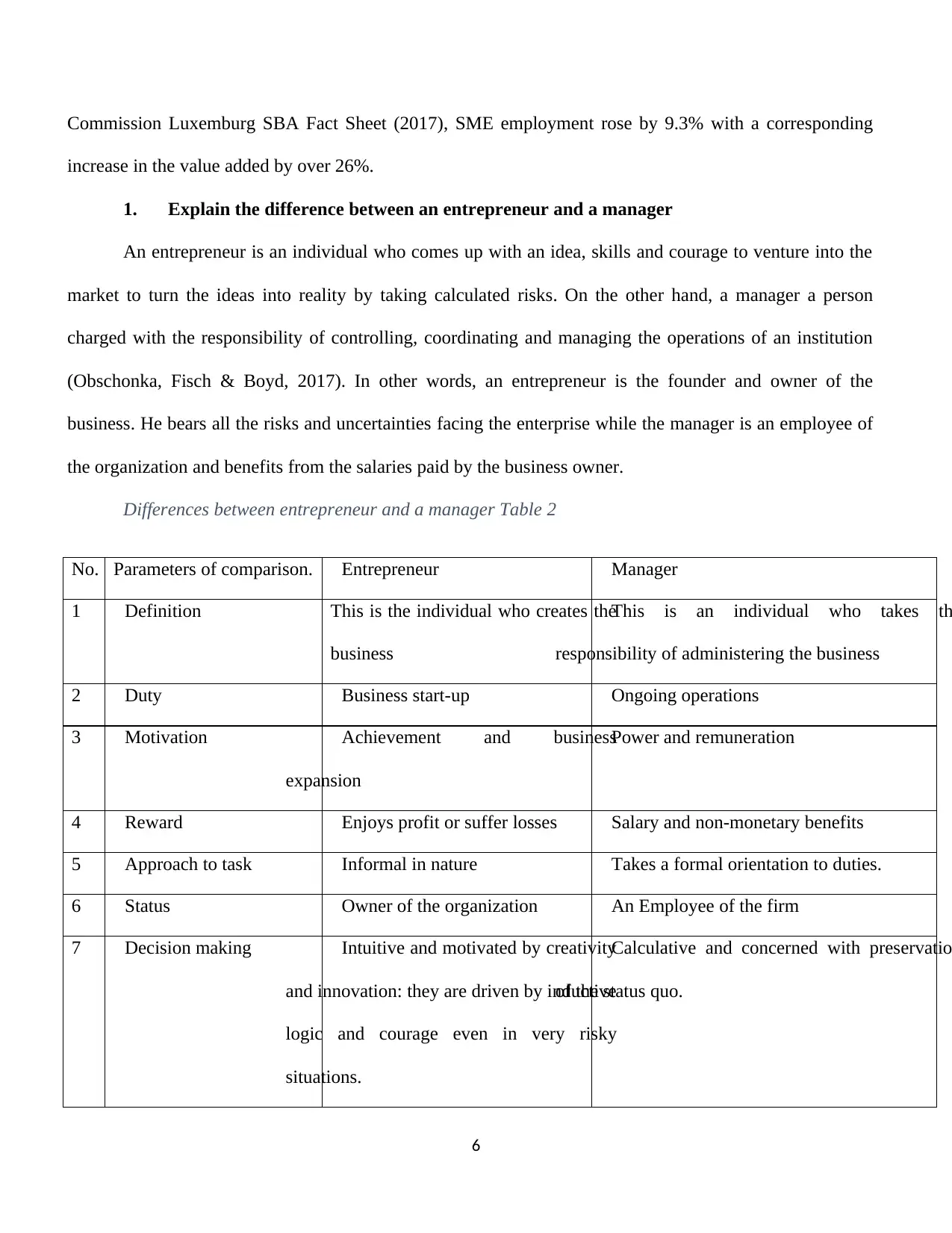
Commission Luxemburg SBA Fact Sheet (2017), SME employment rose by 9.3% with a corresponding
increase in the value added by over 26%.
1. Explain the difference between an entrepreneur and a manager
An entrepreneur is an individual who comes up with an idea, skills and courage to venture into the
market to turn the ideas into reality by taking calculated risks. On the other hand, a manager a person
charged with the responsibility of controlling, coordinating and managing the operations of an institution
(Obschonka, Fisch & Boyd, 2017). In other words, an entrepreneur is the founder and owner of the
business. He bears all the risks and uncertainties facing the enterprise while the manager is an employee of
the organization and benefits from the salaries paid by the business owner.
Differences between entrepreneur and a manager Table 2
No. Parameters of comparison. Entrepreneur Manager
1 Definition This is the individual who creates the
business
This is an individual who takes th
responsibility of administering the business
2 Duty Business start-up Ongoing operations
3 Motivation Achievement and business
expansion
Power and remuneration
4 Reward Enjoys profit or suffer losses Salary and non-monetary benefits
5 Approach to task Informal in nature Takes a formal orientation to duties.
6 Status Owner of the organization An Employee of the firm
7 Decision making Intuitive and motivated by creativity
and innovation: they are driven by inductive
logic and courage even in very risky
situations.
Calculative and concerned with preservatio
of the status quo.
6
increase in the value added by over 26%.
1. Explain the difference between an entrepreneur and a manager
An entrepreneur is an individual who comes up with an idea, skills and courage to venture into the
market to turn the ideas into reality by taking calculated risks. On the other hand, a manager a person
charged with the responsibility of controlling, coordinating and managing the operations of an institution
(Obschonka, Fisch & Boyd, 2017). In other words, an entrepreneur is the founder and owner of the
business. He bears all the risks and uncertainties facing the enterprise while the manager is an employee of
the organization and benefits from the salaries paid by the business owner.
Differences between entrepreneur and a manager Table 2
No. Parameters of comparison. Entrepreneur Manager
1 Definition This is the individual who creates the
business
This is an individual who takes th
responsibility of administering the business
2 Duty Business start-up Ongoing operations
3 Motivation Achievement and business
expansion
Power and remuneration
4 Reward Enjoys profit or suffer losses Salary and non-monetary benefits
5 Approach to task Informal in nature Takes a formal orientation to duties.
6 Status Owner of the organization An Employee of the firm
7 Decision making Intuitive and motivated by creativity
and innovation: they are driven by inductive
logic and courage even in very risky
situations.
Calculative and concerned with preservatio
of the status quo.
6
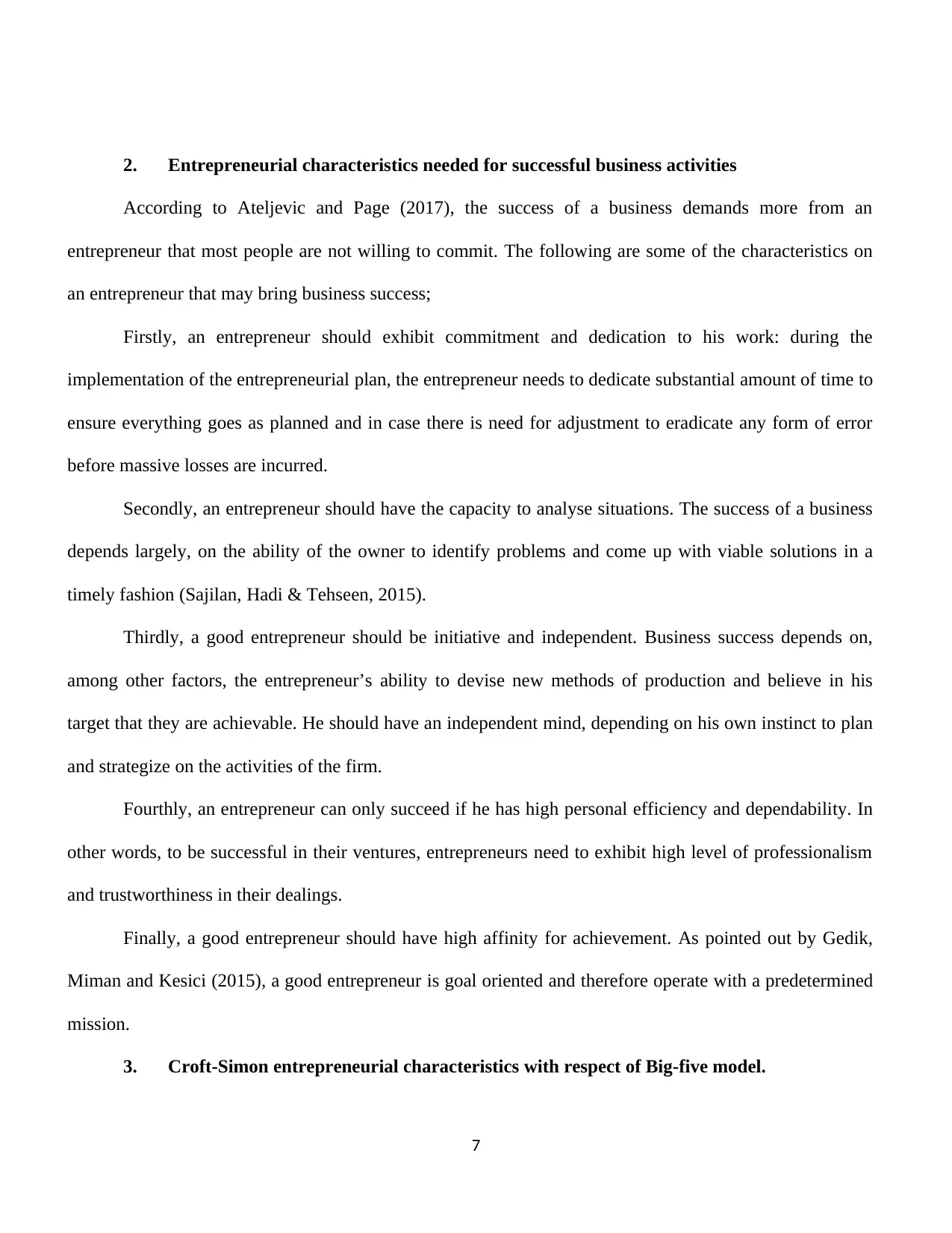
2. Entrepreneurial characteristics needed for successful business activities
According to Ateljevic and Page (2017), the success of a business demands more from an
entrepreneur that most people are not willing to commit. The following are some of the characteristics on
an entrepreneur that may bring business success;
Firstly, an entrepreneur should exhibit commitment and dedication to his work: during the
implementation of the entrepreneurial plan, the entrepreneur needs to dedicate substantial amount of time to
ensure everything goes as planned and in case there is need for adjustment to eradicate any form of error
before massive losses are incurred.
Secondly, an entrepreneur should have the capacity to analyse situations. The success of a business
depends largely, on the ability of the owner to identify problems and come up with viable solutions in a
timely fashion (Sajilan, Hadi & Tehseen, 2015).
Thirdly, a good entrepreneur should be initiative and independent. Business success depends on,
among other factors, the entrepreneur’s ability to devise new methods of production and believe in his
target that they are achievable. He should have an independent mind, depending on his own instinct to plan
and strategize on the activities of the firm.
Fourthly, an entrepreneur can only succeed if he has high personal efficiency and dependability. In
other words, to be successful in their ventures, entrepreneurs need to exhibit high level of professionalism
and trustworthiness in their dealings.
Finally, a good entrepreneur should have high affinity for achievement. As pointed out by Gedik,
Miman and Kesici (2015), a good entrepreneur is goal oriented and therefore operate with a predetermined
mission.
3. Croft-Simon entrepreneurial characteristics with respect of Big-five model.
7
According to Ateljevic and Page (2017), the success of a business demands more from an
entrepreneur that most people are not willing to commit. The following are some of the characteristics on
an entrepreneur that may bring business success;
Firstly, an entrepreneur should exhibit commitment and dedication to his work: during the
implementation of the entrepreneurial plan, the entrepreneur needs to dedicate substantial amount of time to
ensure everything goes as planned and in case there is need for adjustment to eradicate any form of error
before massive losses are incurred.
Secondly, an entrepreneur should have the capacity to analyse situations. The success of a business
depends largely, on the ability of the owner to identify problems and come up with viable solutions in a
timely fashion (Sajilan, Hadi & Tehseen, 2015).
Thirdly, a good entrepreneur should be initiative and independent. Business success depends on,
among other factors, the entrepreneur’s ability to devise new methods of production and believe in his
target that they are achievable. He should have an independent mind, depending on his own instinct to plan
and strategize on the activities of the firm.
Fourthly, an entrepreneur can only succeed if he has high personal efficiency and dependability. In
other words, to be successful in their ventures, entrepreneurs need to exhibit high level of professionalism
and trustworthiness in their dealings.
Finally, a good entrepreneur should have high affinity for achievement. As pointed out by Gedik,
Miman and Kesici (2015), a good entrepreneur is goal oriented and therefore operate with a predetermined
mission.
3. Croft-Simon entrepreneurial characteristics with respect of Big-five model.
7
Paraphrase This Document
Need a fresh take? Get an instant paraphrase of this document with our AI Paraphraser
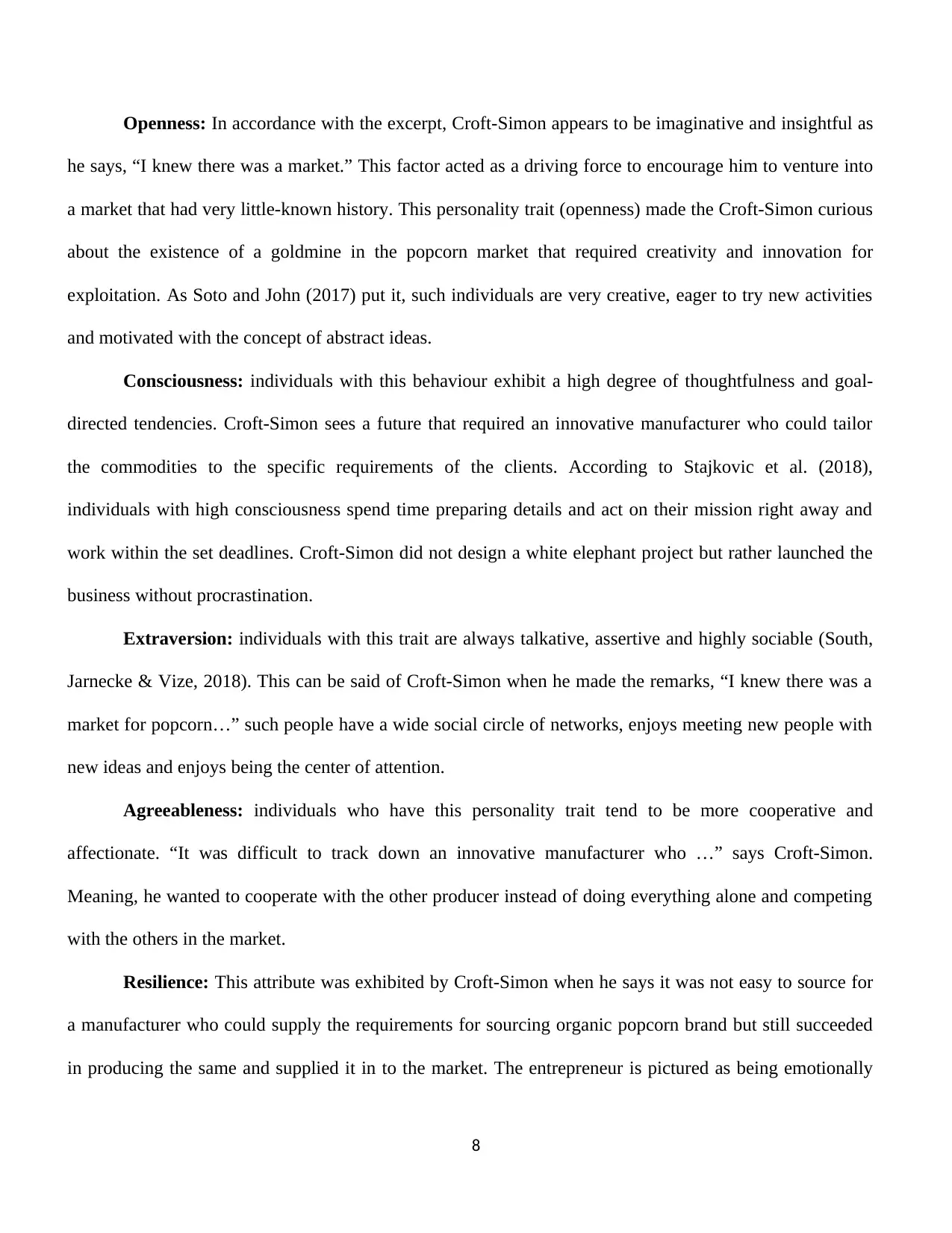
Openness: In accordance with the excerpt, Croft-Simon appears to be imaginative and insightful as
he says, “I knew there was a market.” This factor acted as a driving force to encourage him to venture into
a market that had very little-known history. This personality trait (openness) made the Croft-Simon curious
about the existence of a goldmine in the popcorn market that required creativity and innovation for
exploitation. As Soto and John (2017) put it, such individuals are very creative, eager to try new activities
and motivated with the concept of abstract ideas.
Consciousness: individuals with this behaviour exhibit a high degree of thoughtfulness and goal-
directed tendencies. Croft-Simon sees a future that required an innovative manufacturer who could tailor
the commodities to the specific requirements of the clients. According to Stajkovic et al. (2018),
individuals with high consciousness spend time preparing details and act on their mission right away and
work within the set deadlines. Croft-Simon did not design a white elephant project but rather launched the
business without procrastination.
Extraversion: individuals with this trait are always talkative, assertive and highly sociable (South,
Jarnecke & Vize, 2018). This can be said of Croft-Simon when he made the remarks, “I knew there was a
market for popcorn…” such people have a wide social circle of networks, enjoys meeting new people with
new ideas and enjoys being the center of attention.
Agreeableness: individuals who have this personality trait tend to be more cooperative and
affectionate. “It was difficult to track down an innovative manufacturer who …” says Croft-Simon.
Meaning, he wanted to cooperate with the other producer instead of doing everything alone and competing
with the others in the market.
Resilience: This attribute was exhibited by Croft-Simon when he says it was not easy to source for
a manufacturer who could supply the requirements for sourcing organic popcorn brand but still succeeded
in producing the same and supplied it in to the market. The entrepreneur is pictured as being emotionally
8
he says, “I knew there was a market.” This factor acted as a driving force to encourage him to venture into
a market that had very little-known history. This personality trait (openness) made the Croft-Simon curious
about the existence of a goldmine in the popcorn market that required creativity and innovation for
exploitation. As Soto and John (2017) put it, such individuals are very creative, eager to try new activities
and motivated with the concept of abstract ideas.
Consciousness: individuals with this behaviour exhibit a high degree of thoughtfulness and goal-
directed tendencies. Croft-Simon sees a future that required an innovative manufacturer who could tailor
the commodities to the specific requirements of the clients. According to Stajkovic et al. (2018),
individuals with high consciousness spend time preparing details and act on their mission right away and
work within the set deadlines. Croft-Simon did not design a white elephant project but rather launched the
business without procrastination.
Extraversion: individuals with this trait are always talkative, assertive and highly sociable (South,
Jarnecke & Vize, 2018). This can be said of Croft-Simon when he made the remarks, “I knew there was a
market for popcorn…” such people have a wide social circle of networks, enjoys meeting new people with
new ideas and enjoys being the center of attention.
Agreeableness: individuals who have this personality trait tend to be more cooperative and
affectionate. “It was difficult to track down an innovative manufacturer who …” says Croft-Simon.
Meaning, he wanted to cooperate with the other producer instead of doing everything alone and competing
with the others in the market.
Resilience: This attribute was exhibited by Croft-Simon when he says it was not easy to source for
a manufacturer who could supply the requirements for sourcing organic popcorn brand but still succeeded
in producing the same and supplied it in to the market. The entrepreneur is pictured as being emotionally
8
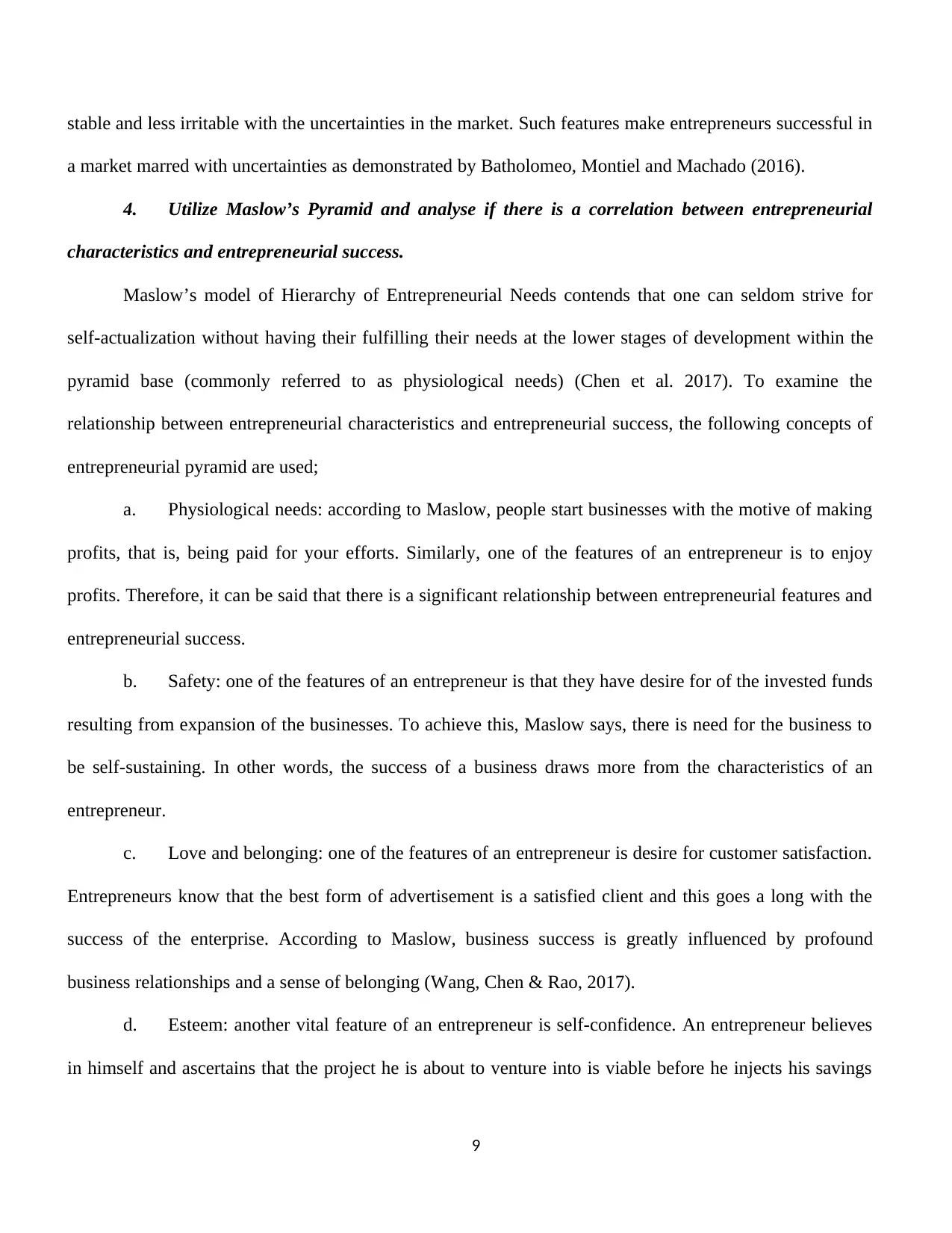
stable and less irritable with the uncertainties in the market. Such features make entrepreneurs successful in
a market marred with uncertainties as demonstrated by Batholomeo, Montiel and Machado (2016).
4. Utilize Maslow’s Pyramid and analyse if there is a correlation between entrepreneurial
characteristics and entrepreneurial success.
Maslow’s model of Hierarchy of Entrepreneurial Needs contends that one can seldom strive for
self-actualization without having their fulfilling their needs at the lower stages of development within the
pyramid base (commonly referred to as physiological needs) (Chen et al. 2017). To examine the
relationship between entrepreneurial characteristics and entrepreneurial success, the following concepts of
entrepreneurial pyramid are used;
a. Physiological needs: according to Maslow, people start businesses with the motive of making
profits, that is, being paid for your efforts. Similarly, one of the features of an entrepreneur is to enjoy
profits. Therefore, it can be said that there is a significant relationship between entrepreneurial features and
entrepreneurial success.
b. Safety: one of the features of an entrepreneur is that they have desire for of the invested funds
resulting from expansion of the businesses. To achieve this, Maslow says, there is need for the business to
be self-sustaining. In other words, the success of a business draws more from the characteristics of an
entrepreneur.
c. Love and belonging: one of the features of an entrepreneur is desire for customer satisfaction.
Entrepreneurs know that the best form of advertisement is a satisfied client and this goes a long with the
success of the enterprise. According to Maslow, business success is greatly influenced by profound
business relationships and a sense of belonging (Wang, Chen & Rao, 2017).
d. Esteem: another vital feature of an entrepreneur is self-confidence. An entrepreneur believes
in himself and ascertains that the project he is about to venture into is viable before he injects his savings
9
a market marred with uncertainties as demonstrated by Batholomeo, Montiel and Machado (2016).
4. Utilize Maslow’s Pyramid and analyse if there is a correlation between entrepreneurial
characteristics and entrepreneurial success.
Maslow’s model of Hierarchy of Entrepreneurial Needs contends that one can seldom strive for
self-actualization without having their fulfilling their needs at the lower stages of development within the
pyramid base (commonly referred to as physiological needs) (Chen et al. 2017). To examine the
relationship between entrepreneurial characteristics and entrepreneurial success, the following concepts of
entrepreneurial pyramid are used;
a. Physiological needs: according to Maslow, people start businesses with the motive of making
profits, that is, being paid for your efforts. Similarly, one of the features of an entrepreneur is to enjoy
profits. Therefore, it can be said that there is a significant relationship between entrepreneurial features and
entrepreneurial success.
b. Safety: one of the features of an entrepreneur is that they have desire for of the invested funds
resulting from expansion of the businesses. To achieve this, Maslow says, there is need for the business to
be self-sustaining. In other words, the success of a business draws more from the characteristics of an
entrepreneur.
c. Love and belonging: one of the features of an entrepreneur is desire for customer satisfaction.
Entrepreneurs know that the best form of advertisement is a satisfied client and this goes a long with the
success of the enterprise. According to Maslow, business success is greatly influenced by profound
business relationships and a sense of belonging (Wang, Chen & Rao, 2017).
d. Esteem: another vital feature of an entrepreneur is self-confidence. An entrepreneur believes
in himself and ascertains that the project he is about to venture into is viable before he injects his savings
9
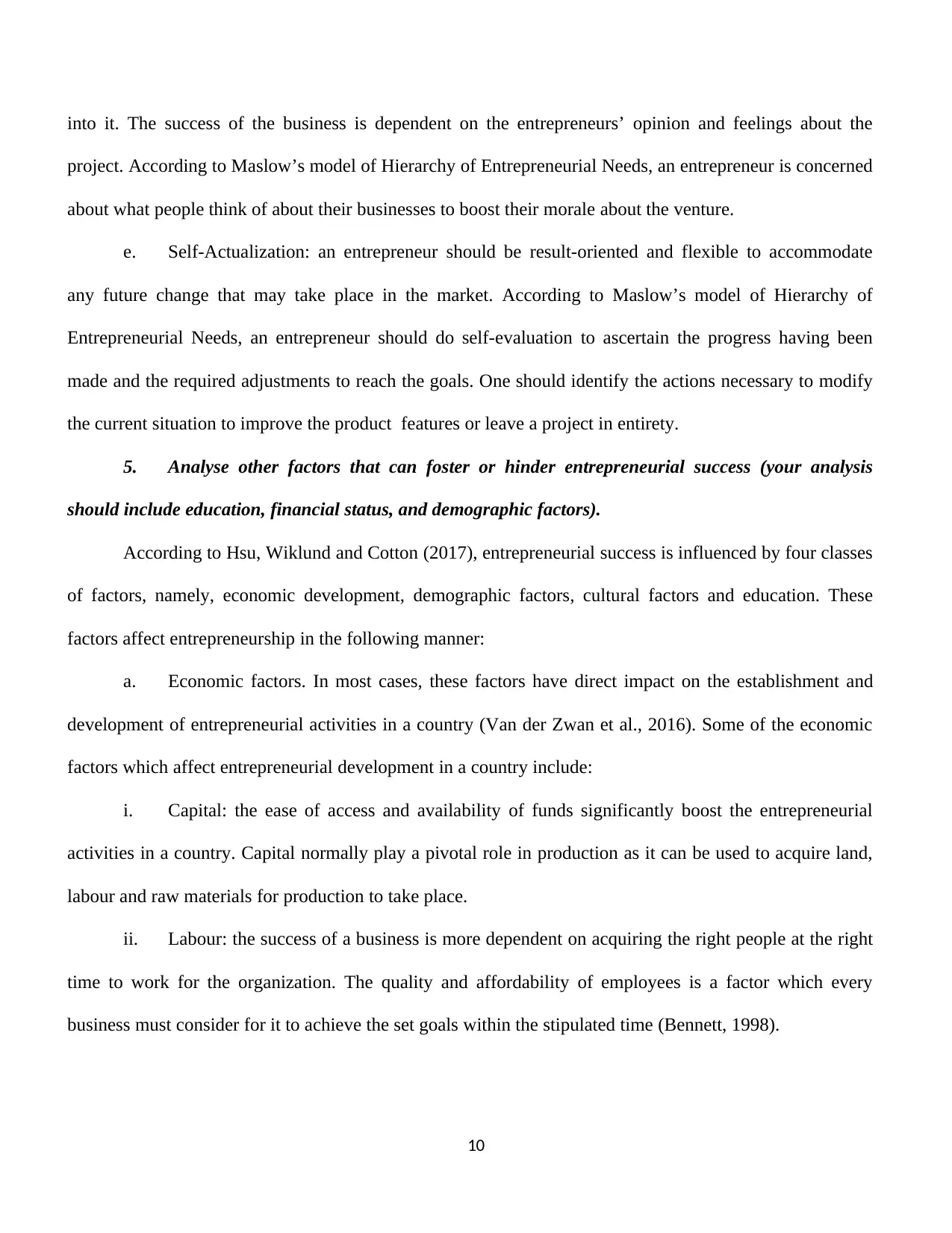
into it. The success of the business is dependent on the entrepreneurs’ opinion and feelings about the
project. According to Maslow’s model of Hierarchy of Entrepreneurial Needs, an entrepreneur is concerned
about what people think of about their businesses to boost their morale about the venture.
e. Self-Actualization: an entrepreneur should be result-oriented and flexible to accommodate
any future change that may take place in the market. According to Maslow’s model of Hierarchy of
Entrepreneurial Needs, an entrepreneur should do self-evaluation to ascertain the progress having been
made and the required adjustments to reach the goals. One should identify the actions necessary to modify
the current situation to improve the product features or leave a project in entirety.
5. Analyse other factors that can foster or hinder entrepreneurial success (your analysis
should include education, financial status, and demographic factors).
According to Hsu, Wiklund and Cotton (2017), entrepreneurial success is influenced by four classes
of factors, namely, economic development, demographic factors, cultural factors and education. These
factors affect entrepreneurship in the following manner:
a. Economic factors. In most cases, these factors have direct impact on the establishment and
development of entrepreneurial activities in a country (Van der Zwan et al., 2016). Some of the economic
factors which affect entrepreneurial development in a country include:
i. Capital: the ease of access and availability of funds significantly boost the entrepreneurial
activities in a country. Capital normally play a pivotal role in production as it can be used to acquire land,
labour and raw materials for production to take place.
ii. Labour: the success of a business is more dependent on acquiring the right people at the right
time to work for the organization. The quality and affordability of employees is a factor which every
business must consider for it to achieve the set goals within the stipulated time (Bennett, 1998).
10
project. According to Maslow’s model of Hierarchy of Entrepreneurial Needs, an entrepreneur is concerned
about what people think of about their businesses to boost their morale about the venture.
e. Self-Actualization: an entrepreneur should be result-oriented and flexible to accommodate
any future change that may take place in the market. According to Maslow’s model of Hierarchy of
Entrepreneurial Needs, an entrepreneur should do self-evaluation to ascertain the progress having been
made and the required adjustments to reach the goals. One should identify the actions necessary to modify
the current situation to improve the product features or leave a project in entirety.
5. Analyse other factors that can foster or hinder entrepreneurial success (your analysis
should include education, financial status, and demographic factors).
According to Hsu, Wiklund and Cotton (2017), entrepreneurial success is influenced by four classes
of factors, namely, economic development, demographic factors, cultural factors and education. These
factors affect entrepreneurship in the following manner:
a. Economic factors. In most cases, these factors have direct impact on the establishment and
development of entrepreneurial activities in a country (Van der Zwan et al., 2016). Some of the economic
factors which affect entrepreneurial development in a country include:
i. Capital: the ease of access and availability of funds significantly boost the entrepreneurial
activities in a country. Capital normally play a pivotal role in production as it can be used to acquire land,
labour and raw materials for production to take place.
ii. Labour: the success of a business is more dependent on acquiring the right people at the right
time to work for the organization. The quality and affordability of employees is a factor which every
business must consider for it to achieve the set goals within the stipulated time (Bennett, 1998).
10
Secure Best Marks with AI Grader
Need help grading? Try our AI Grader for instant feedback on your assignments.
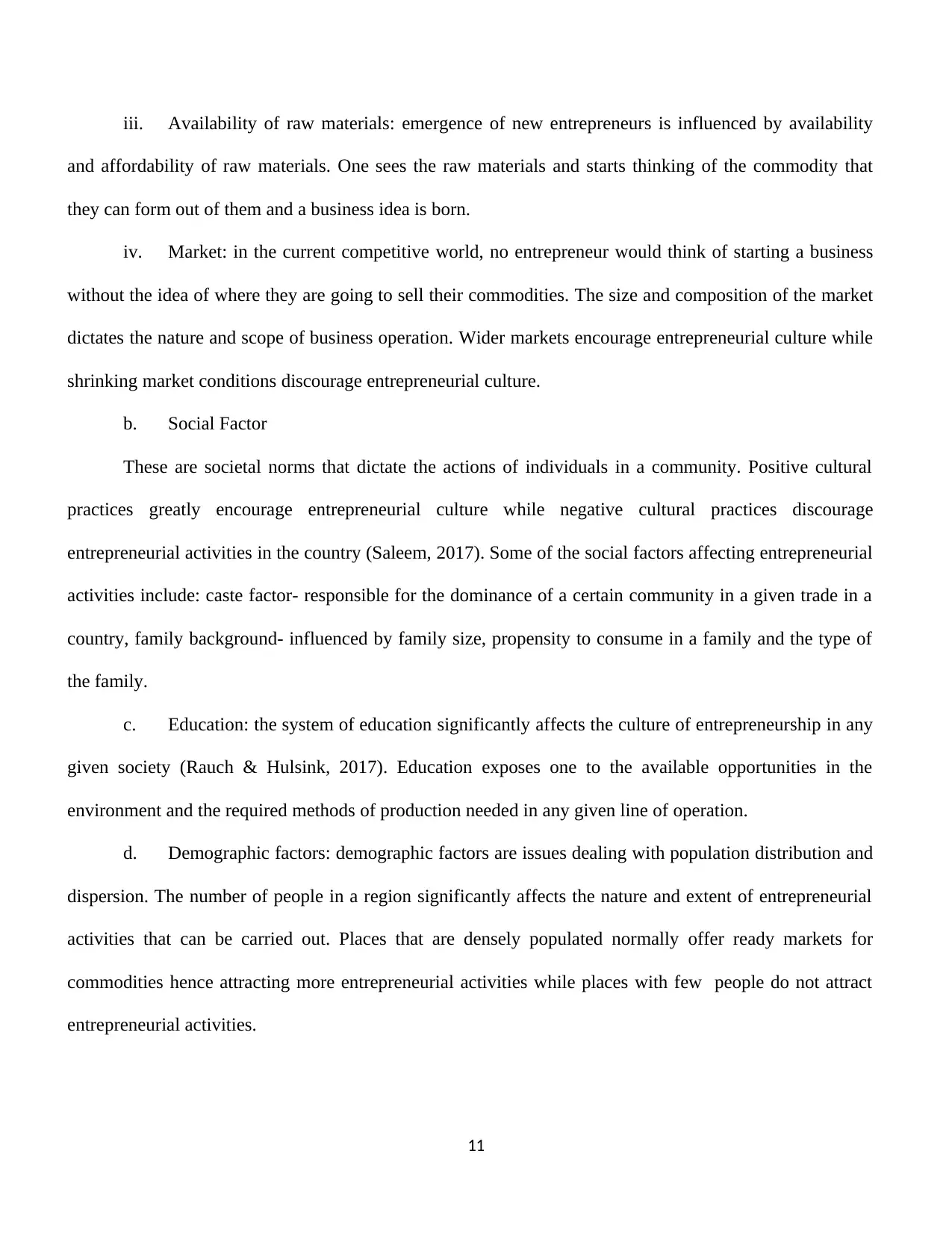
iii. Availability of raw materials: emergence of new entrepreneurs is influenced by availability
and affordability of raw materials. One sees the raw materials and starts thinking of the commodity that
they can form out of them and a business idea is born.
iv. Market: in the current competitive world, no entrepreneur would think of starting a business
without the idea of where they are going to sell their commodities. The size and composition of the market
dictates the nature and scope of business operation. Wider markets encourage entrepreneurial culture while
shrinking market conditions discourage entrepreneurial culture.
b. Social Factor
These are societal norms that dictate the actions of individuals in a community. Positive cultural
practices greatly encourage entrepreneurial culture while negative cultural practices discourage
entrepreneurial activities in the country (Saleem, 2017). Some of the social factors affecting entrepreneurial
activities include: caste factor- responsible for the dominance of a certain community in a given trade in a
country, family background- influenced by family size, propensity to consume in a family and the type of
the family.
c. Education: the system of education significantly affects the culture of entrepreneurship in any
given society (Rauch & Hulsink, 2017). Education exposes one to the available opportunities in the
environment and the required methods of production needed in any given line of operation.
d. Demographic factors: demographic factors are issues dealing with population distribution and
dispersion. The number of people in a region significantly affects the nature and extent of entrepreneurial
activities that can be carried out. Places that are densely populated normally offer ready markets for
commodities hence attracting more entrepreneurial activities while places with few people do not attract
entrepreneurial activities.
11
and affordability of raw materials. One sees the raw materials and starts thinking of the commodity that
they can form out of them and a business idea is born.
iv. Market: in the current competitive world, no entrepreneur would think of starting a business
without the idea of where they are going to sell their commodities. The size and composition of the market
dictates the nature and scope of business operation. Wider markets encourage entrepreneurial culture while
shrinking market conditions discourage entrepreneurial culture.
b. Social Factor
These are societal norms that dictate the actions of individuals in a community. Positive cultural
practices greatly encourage entrepreneurial culture while negative cultural practices discourage
entrepreneurial activities in the country (Saleem, 2017). Some of the social factors affecting entrepreneurial
activities include: caste factor- responsible for the dominance of a certain community in a given trade in a
country, family background- influenced by family size, propensity to consume in a family and the type of
the family.
c. Education: the system of education significantly affects the culture of entrepreneurship in any
given society (Rauch & Hulsink, 2017). Education exposes one to the available opportunities in the
environment and the required methods of production needed in any given line of operation.
d. Demographic factors: demographic factors are issues dealing with population distribution and
dispersion. The number of people in a region significantly affects the nature and extent of entrepreneurial
activities that can be carried out. Places that are densely populated normally offer ready markets for
commodities hence attracting more entrepreneurial activities while places with few people do not attract
entrepreneurial activities.
11
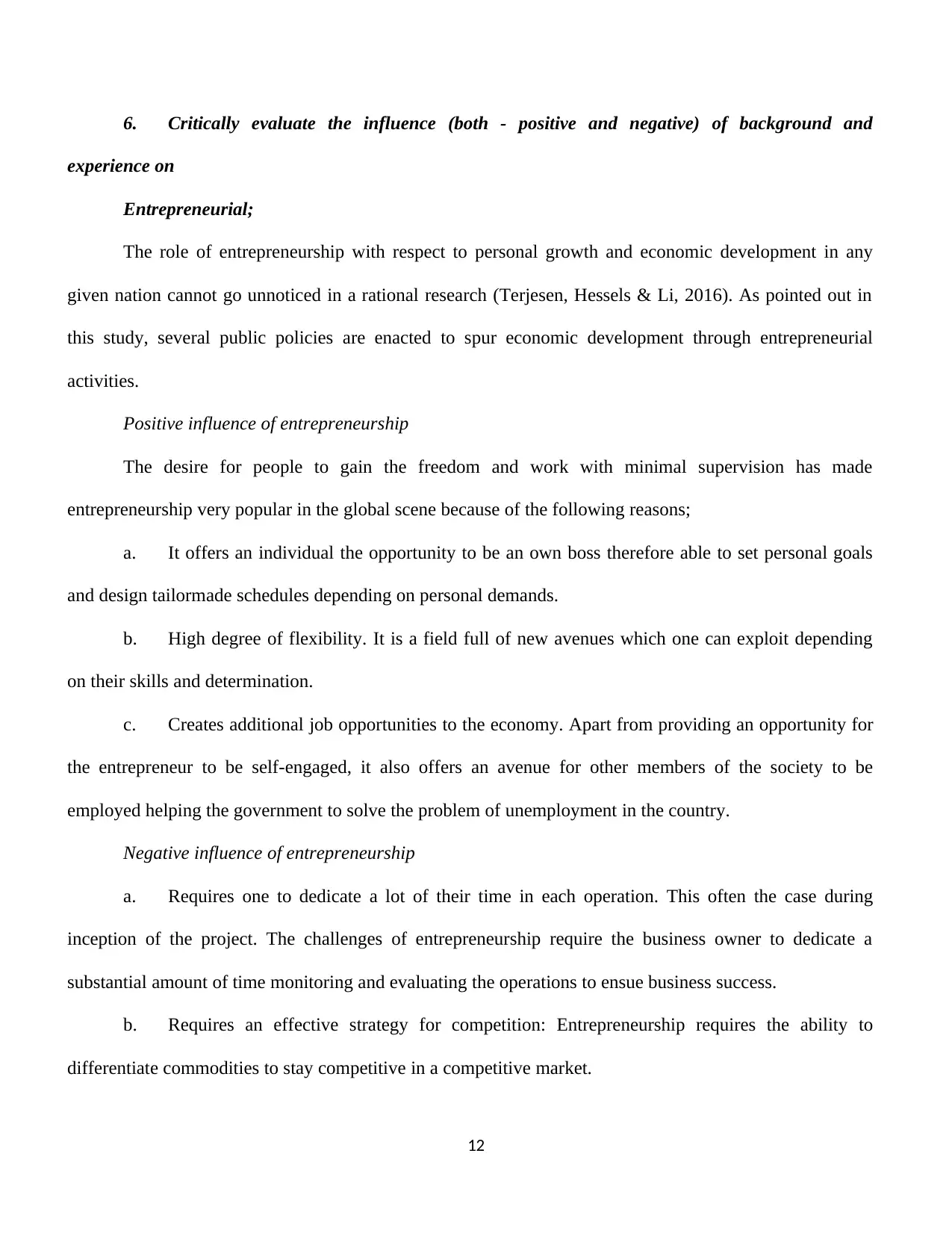
6. Critically evaluate the influence (both - positive and negative) of background and
experience on
Entrepreneurial;
The role of entrepreneurship with respect to personal growth and economic development in any
given nation cannot go unnoticed in a rational research (Terjesen, Hessels & Li, 2016). As pointed out in
this study, several public policies are enacted to spur economic development through entrepreneurial
activities.
Positive influence of entrepreneurship
The desire for people to gain the freedom and work with minimal supervision has made
entrepreneurship very popular in the global scene because of the following reasons;
a. It offers an individual the opportunity to be an own boss therefore able to set personal goals
and design tailormade schedules depending on personal demands.
b. High degree of flexibility. It is a field full of new avenues which one can exploit depending
on their skills and determination.
c. Creates additional job opportunities to the economy. Apart from providing an opportunity for
the entrepreneur to be self-engaged, it also offers an avenue for other members of the society to be
employed helping the government to solve the problem of unemployment in the country.
Negative influence of entrepreneurship
a. Requires one to dedicate a lot of their time in each operation. This often the case during
inception of the project. The challenges of entrepreneurship require the business owner to dedicate a
substantial amount of time monitoring and evaluating the operations to ensue business success.
b. Requires an effective strategy for competition: Entrepreneurship requires the ability to
differentiate commodities to stay competitive in a competitive market.
12
experience on
Entrepreneurial;
The role of entrepreneurship with respect to personal growth and economic development in any
given nation cannot go unnoticed in a rational research (Terjesen, Hessels & Li, 2016). As pointed out in
this study, several public policies are enacted to spur economic development through entrepreneurial
activities.
Positive influence of entrepreneurship
The desire for people to gain the freedom and work with minimal supervision has made
entrepreneurship very popular in the global scene because of the following reasons;
a. It offers an individual the opportunity to be an own boss therefore able to set personal goals
and design tailormade schedules depending on personal demands.
b. High degree of flexibility. It is a field full of new avenues which one can exploit depending
on their skills and determination.
c. Creates additional job opportunities to the economy. Apart from providing an opportunity for
the entrepreneur to be self-engaged, it also offers an avenue for other members of the society to be
employed helping the government to solve the problem of unemployment in the country.
Negative influence of entrepreneurship
a. Requires one to dedicate a lot of their time in each operation. This often the case during
inception of the project. The challenges of entrepreneurship require the business owner to dedicate a
substantial amount of time monitoring and evaluating the operations to ensue business success.
b. Requires an effective strategy for competition: Entrepreneurship requires the ability to
differentiate commodities to stay competitive in a competitive market.
12
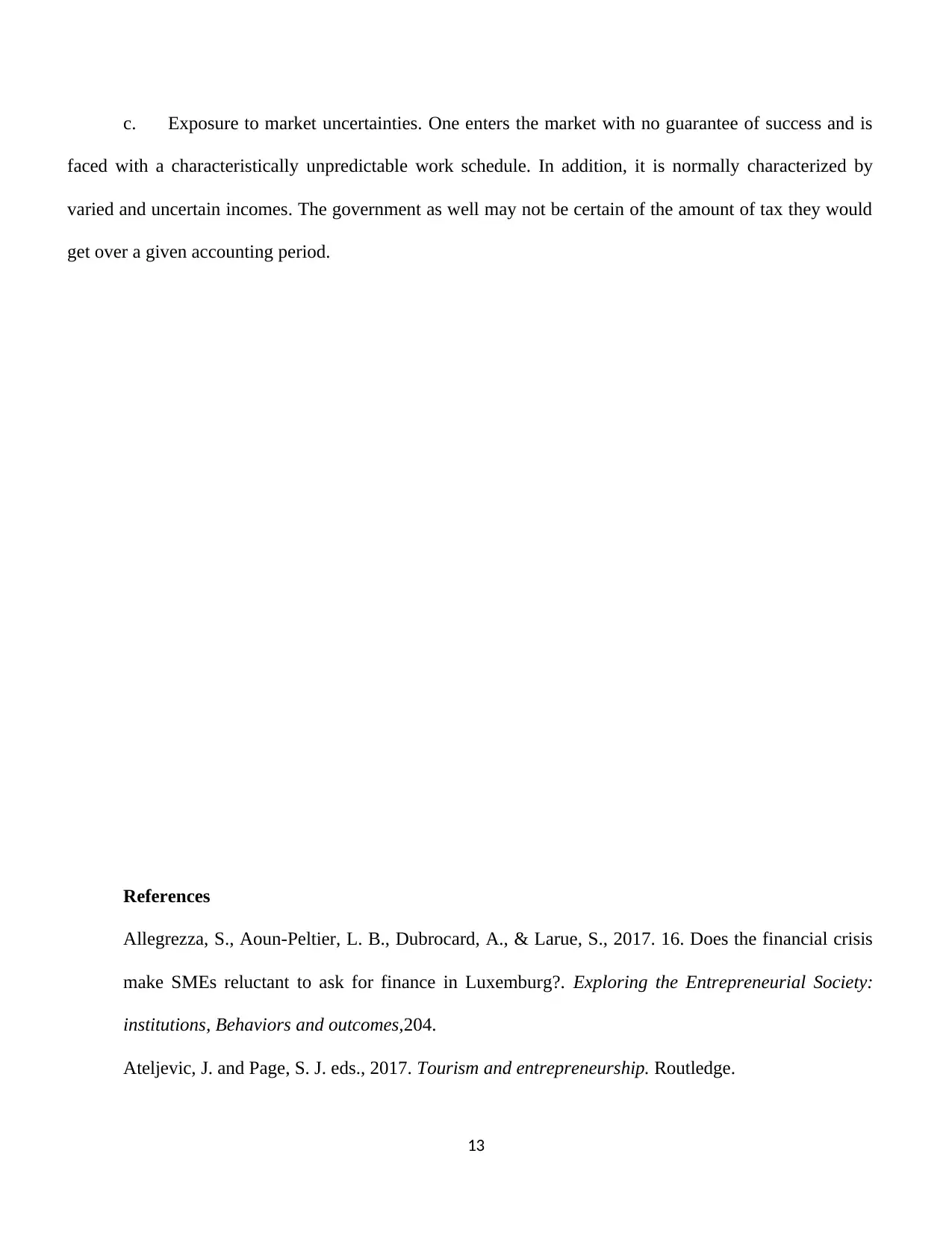
c. Exposure to market uncertainties. One enters the market with no guarantee of success and is
faced with a characteristically unpredictable work schedule. In addition, it is normally characterized by
varied and uncertain incomes. The government as well may not be certain of the amount of tax they would
get over a given accounting period.
References
Allegrezza, S., Aoun-Peltier, L. B., Dubrocard, A., & Larue, S., 2017. 16. Does the financial crisis
make SMEs reluctant to ask for finance in Luxemburg?. Exploring the Entrepreneurial Society:
institutions, Behaviors and outcomes,204.
Ateljevic, J. and Page, S. J. eds., 2017. Tourism and entrepreneurship. Routledge.
13
faced with a characteristically unpredictable work schedule. In addition, it is normally characterized by
varied and uncertain incomes. The government as well may not be certain of the amount of tax they would
get over a given accounting period.
References
Allegrezza, S., Aoun-Peltier, L. B., Dubrocard, A., & Larue, S., 2017. 16. Does the financial crisis
make SMEs reluctant to ask for finance in Luxemburg?. Exploring the Entrepreneurial Society:
institutions, Behaviors and outcomes,204.
Ateljevic, J. and Page, S. J. eds., 2017. Tourism and entrepreneurship. Routledge.
13
Paraphrase This Document
Need a fresh take? Get an instant paraphrase of this document with our AI Paraphraser
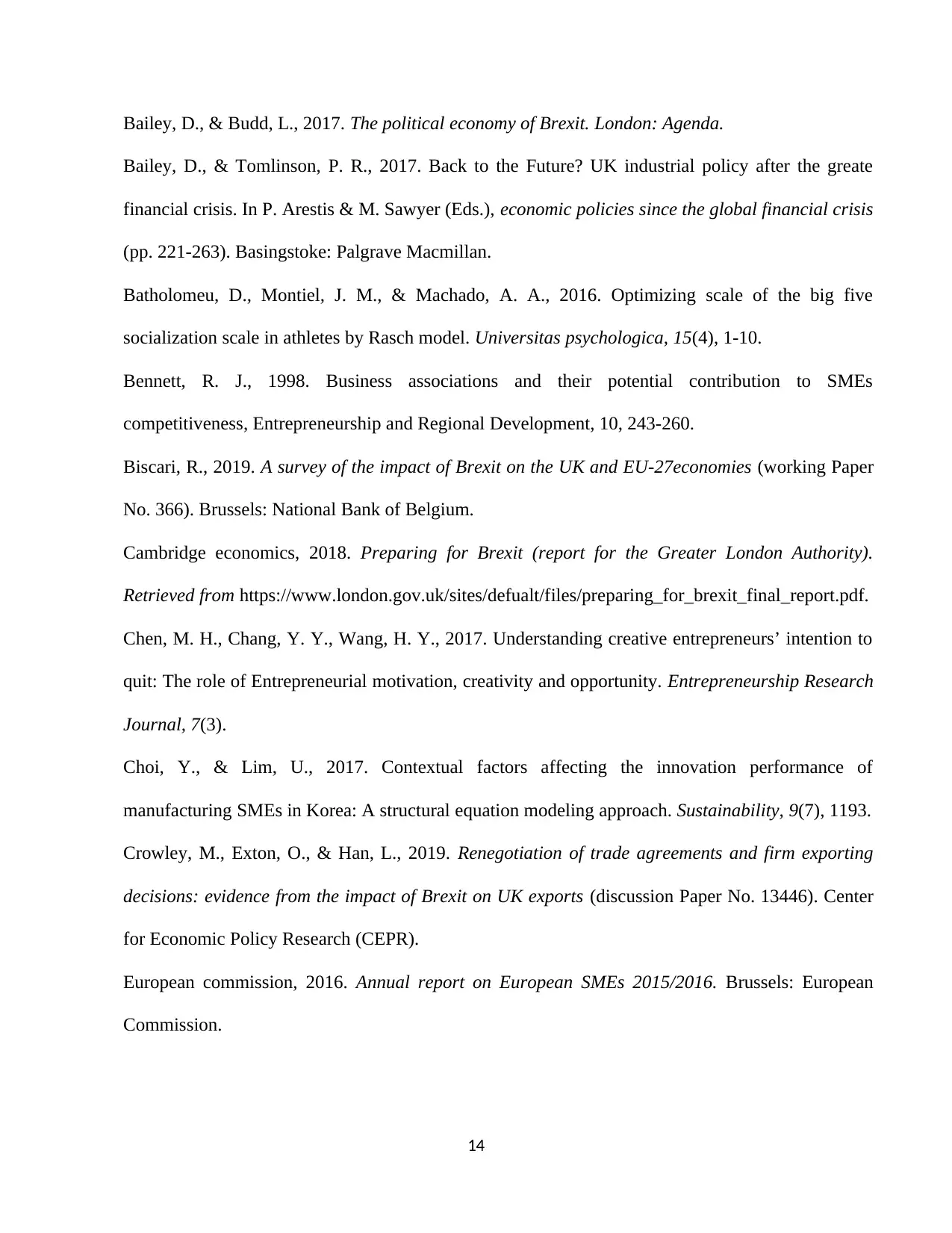
Bailey, D., & Budd, L., 2017. The political economy of Brexit. London: Agenda.
Bailey, D., & Tomlinson, P. R., 2017. Back to the Future? UK industrial policy after the greate
financial crisis. In P. Arestis & M. Sawyer (Eds.), economic policies since the global financial crisis
(pp. 221-263). Basingstoke: Palgrave Macmillan.
Batholomeu, D., Montiel, J. M., & Machado, A. A., 2016. Optimizing scale of the big five
socialization scale in athletes by Rasch model. Universitas psychologica, 15(4), 1-10.
Bennett, R. J., 1998. Business associations and their potential contribution to SMEs
competitiveness, Entrepreneurship and Regional Development, 10, 243-260.
Biscari, R., 2019. A survey of the impact of Brexit on the UK and EU-27economies (working Paper
No. 366). Brussels: National Bank of Belgium.
Cambridge economics, 2018. Preparing for Brexit (report for the Greater London Authority).
Retrieved from https://www.london.gov.uk/sites/defualt/files/preparing_for_brexit_final_report.pdf.
Chen, M. H., Chang, Y. Y., Wang, H. Y., 2017. Understanding creative entrepreneurs’ intention to
quit: The role of Entrepreneurial motivation, creativity and opportunity. Entrepreneurship Research
Journal, 7(3).
Choi, Y., & Lim, U., 2017. Contextual factors affecting the innovation performance of
manufacturing SMEs in Korea: A structural equation modeling approach. Sustainability, 9(7), 1193.
Crowley, M., Exton, O., & Han, L., 2019. Renegotiation of trade agreements and firm exporting
decisions: evidence from the impact of Brexit on UK exports (discussion Paper No. 13446). Center
for Economic Policy Research (CEPR).
European commission, 2016. Annual report on European SMEs 2015/2016. Brussels: European
Commission.
14
Bailey, D., & Tomlinson, P. R., 2017. Back to the Future? UK industrial policy after the greate
financial crisis. In P. Arestis & M. Sawyer (Eds.), economic policies since the global financial crisis
(pp. 221-263). Basingstoke: Palgrave Macmillan.
Batholomeu, D., Montiel, J. M., & Machado, A. A., 2016. Optimizing scale of the big five
socialization scale in athletes by Rasch model. Universitas psychologica, 15(4), 1-10.
Bennett, R. J., 1998. Business associations and their potential contribution to SMEs
competitiveness, Entrepreneurship and Regional Development, 10, 243-260.
Biscari, R., 2019. A survey of the impact of Brexit on the UK and EU-27economies (working Paper
No. 366). Brussels: National Bank of Belgium.
Cambridge economics, 2018. Preparing for Brexit (report for the Greater London Authority).
Retrieved from https://www.london.gov.uk/sites/defualt/files/preparing_for_brexit_final_report.pdf.
Chen, M. H., Chang, Y. Y., Wang, H. Y., 2017. Understanding creative entrepreneurs’ intention to
quit: The role of Entrepreneurial motivation, creativity and opportunity. Entrepreneurship Research
Journal, 7(3).
Choi, Y., & Lim, U., 2017. Contextual factors affecting the innovation performance of
manufacturing SMEs in Korea: A structural equation modeling approach. Sustainability, 9(7), 1193.
Crowley, M., Exton, O., & Han, L., 2019. Renegotiation of trade agreements and firm exporting
decisions: evidence from the impact of Brexit on UK exports (discussion Paper No. 13446). Center
for Economic Policy Research (CEPR).
European commission, 2016. Annual report on European SMEs 2015/2016. Brussels: European
Commission.
14
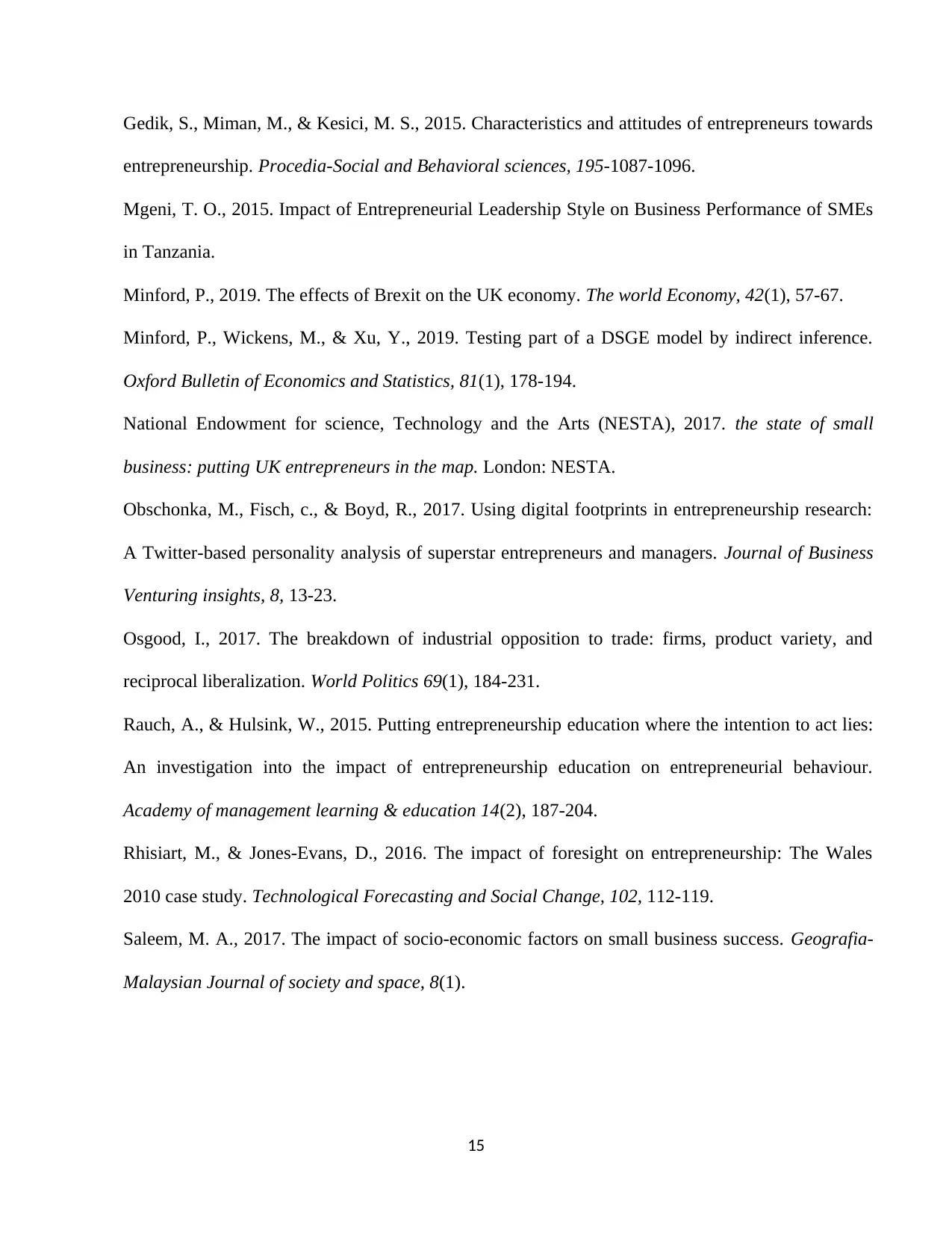
Gedik, S., Miman, M., & Kesici, M. S., 2015. Characteristics and attitudes of entrepreneurs towards
entrepreneurship. Procedia-Social and Behavioral sciences, 195-1087-1096.
Mgeni, T. O., 2015. Impact of Entrepreneurial Leadership Style on Business Performance of SMEs
in Tanzania.
Minford, P., 2019. The effects of Brexit on the UK economy. The world Economy, 42(1), 57-67.
Minford, P., Wickens, M., & Xu, Y., 2019. Testing part of a DSGE model by indirect inference.
Oxford Bulletin of Economics and Statistics, 81(1), 178-194.
National Endowment for science, Technology and the Arts (NESTA), 2017. the state of small
business: putting UK entrepreneurs in the map. London: NESTA.
Obschonka, M., Fisch, c., & Boyd, R., 2017. Using digital footprints in entrepreneurship research:
A Twitter-based personality analysis of superstar entrepreneurs and managers. Journal of Business
Venturing insights, 8, 13-23.
Osgood, I., 2017. The breakdown of industrial opposition to trade: firms, product variety, and
reciprocal liberalization. World Politics 69(1), 184-231.
Rauch, A., & Hulsink, W., 2015. Putting entrepreneurship education where the intention to act lies:
An investigation into the impact of entrepreneurship education on entrepreneurial behaviour.
Academy of management learning & education 14(2), 187-204.
Rhisiart, M., & Jones-Evans, D., 2016. The impact of foresight on entrepreneurship: The Wales
2010 case study. Technological Forecasting and Social Change, 102, 112-119.
Saleem, M. A., 2017. The impact of socio-economic factors on small business success. Geografia-
Malaysian Journal of society and space, 8(1).
15
entrepreneurship. Procedia-Social and Behavioral sciences, 195-1087-1096.
Mgeni, T. O., 2015. Impact of Entrepreneurial Leadership Style on Business Performance of SMEs
in Tanzania.
Minford, P., 2019. The effects of Brexit on the UK economy. The world Economy, 42(1), 57-67.
Minford, P., Wickens, M., & Xu, Y., 2019. Testing part of a DSGE model by indirect inference.
Oxford Bulletin of Economics and Statistics, 81(1), 178-194.
National Endowment for science, Technology and the Arts (NESTA), 2017. the state of small
business: putting UK entrepreneurs in the map. London: NESTA.
Obschonka, M., Fisch, c., & Boyd, R., 2017. Using digital footprints in entrepreneurship research:
A Twitter-based personality analysis of superstar entrepreneurs and managers. Journal of Business
Venturing insights, 8, 13-23.
Osgood, I., 2017. The breakdown of industrial opposition to trade: firms, product variety, and
reciprocal liberalization. World Politics 69(1), 184-231.
Rauch, A., & Hulsink, W., 2015. Putting entrepreneurship education where the intention to act lies:
An investigation into the impact of entrepreneurship education on entrepreneurial behaviour.
Academy of management learning & education 14(2), 187-204.
Rhisiart, M., & Jones-Evans, D., 2016. The impact of foresight on entrepreneurship: The Wales
2010 case study. Technological Forecasting and Social Change, 102, 112-119.
Saleem, M. A., 2017. The impact of socio-economic factors on small business success. Geografia-
Malaysian Journal of society and space, 8(1).
15
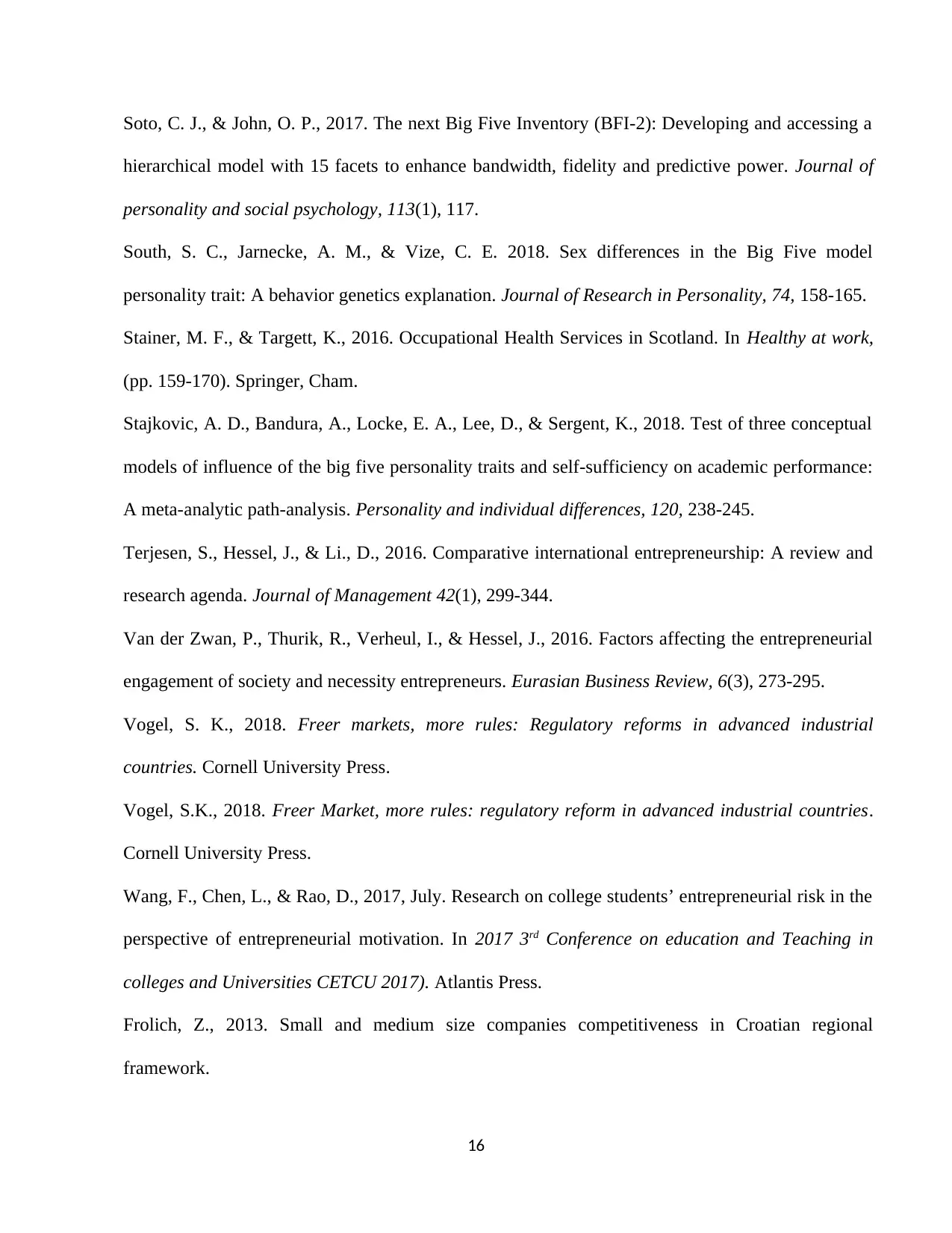
Soto, C. J., & John, O. P., 2017. The next Big Five Inventory (BFI-2): Developing and accessing a
hierarchical model with 15 facets to enhance bandwidth, fidelity and predictive power. Journal of
personality and social psychology, 113(1), 117.
South, S. C., Jarnecke, A. M., & Vize, C. E. 2018. Sex differences in the Big Five model
personality trait: A behavior genetics explanation. Journal of Research in Personality, 74, 158-165.
Stainer, M. F., & Targett, K., 2016. Occupational Health Services in Scotland. In Healthy at work,
(pp. 159-170). Springer, Cham.
Stajkovic, A. D., Bandura, A., Locke, E. A., Lee, D., & Sergent, K., 2018. Test of three conceptual
models of influence of the big five personality traits and self-sufficiency on academic performance:
A meta-analytic path-analysis. Personality and individual differences, 120, 238-245.
Terjesen, S., Hessel, J., & Li., D., 2016. Comparative international entrepreneurship: A review and
research agenda. Journal of Management 42(1), 299-344.
Van der Zwan, P., Thurik, R., Verheul, I., & Hessel, J., 2016. Factors affecting the entrepreneurial
engagement of society and necessity entrepreneurs. Eurasian Business Review, 6(3), 273-295.
Vogel, S. K., 2018. Freer markets, more rules: Regulatory reforms in advanced industrial
countries. Cornell University Press.
Vogel, S.K., 2018. Freer Market, more rules: regulatory reform in advanced industrial countries.
Cornell University Press.
Wang, F., Chen, L., & Rao, D., 2017, July. Research on college students’ entrepreneurial risk in the
perspective of entrepreneurial motivation. In 2017 3rd Conference on education and Teaching in
colleges and Universities CETCU 2017). Atlantis Press.
Frolich, Z., 2013. Small and medium size companies competitiveness in Croatian regional
framework.
16
hierarchical model with 15 facets to enhance bandwidth, fidelity and predictive power. Journal of
personality and social psychology, 113(1), 117.
South, S. C., Jarnecke, A. M., & Vize, C. E. 2018. Sex differences in the Big Five model
personality trait: A behavior genetics explanation. Journal of Research in Personality, 74, 158-165.
Stainer, M. F., & Targett, K., 2016. Occupational Health Services in Scotland. In Healthy at work,
(pp. 159-170). Springer, Cham.
Stajkovic, A. D., Bandura, A., Locke, E. A., Lee, D., & Sergent, K., 2018. Test of three conceptual
models of influence of the big five personality traits and self-sufficiency on academic performance:
A meta-analytic path-analysis. Personality and individual differences, 120, 238-245.
Terjesen, S., Hessel, J., & Li., D., 2016. Comparative international entrepreneurship: A review and
research agenda. Journal of Management 42(1), 299-344.
Van der Zwan, P., Thurik, R., Verheul, I., & Hessel, J., 2016. Factors affecting the entrepreneurial
engagement of society and necessity entrepreneurs. Eurasian Business Review, 6(3), 273-295.
Vogel, S. K., 2018. Freer markets, more rules: Regulatory reforms in advanced industrial
countries. Cornell University Press.
Vogel, S.K., 2018. Freer Market, more rules: regulatory reform in advanced industrial countries.
Cornell University Press.
Wang, F., Chen, L., & Rao, D., 2017, July. Research on college students’ entrepreneurial risk in the
perspective of entrepreneurial motivation. In 2017 3rd Conference on education and Teaching in
colleges and Universities CETCU 2017). Atlantis Press.
Frolich, Z., 2013. Small and medium size companies competitiveness in Croatian regional
framework.
16
Secure Best Marks with AI Grader
Need help grading? Try our AI Grader for instant feedback on your assignments.

17
1 out of 17
Related Documents
Your All-in-One AI-Powered Toolkit for Academic Success.
+13062052269
info@desklib.com
Available 24*7 on WhatsApp / Email
![[object Object]](/_next/static/media/star-bottom.7253800d.svg)
Unlock your academic potential
© 2024 | Zucol Services PVT LTD | All rights reserved.




